When contemplating the selection of dairy cattle breeds for your farm, it’s essential to focus on profitability and milk production. This blog will introduce you to the top 20 dairy cattle breeds that can significantly boost your farm’s milk production and revenue. You can ensure a thriving and prosperous dairy farm by choosing the right breed.
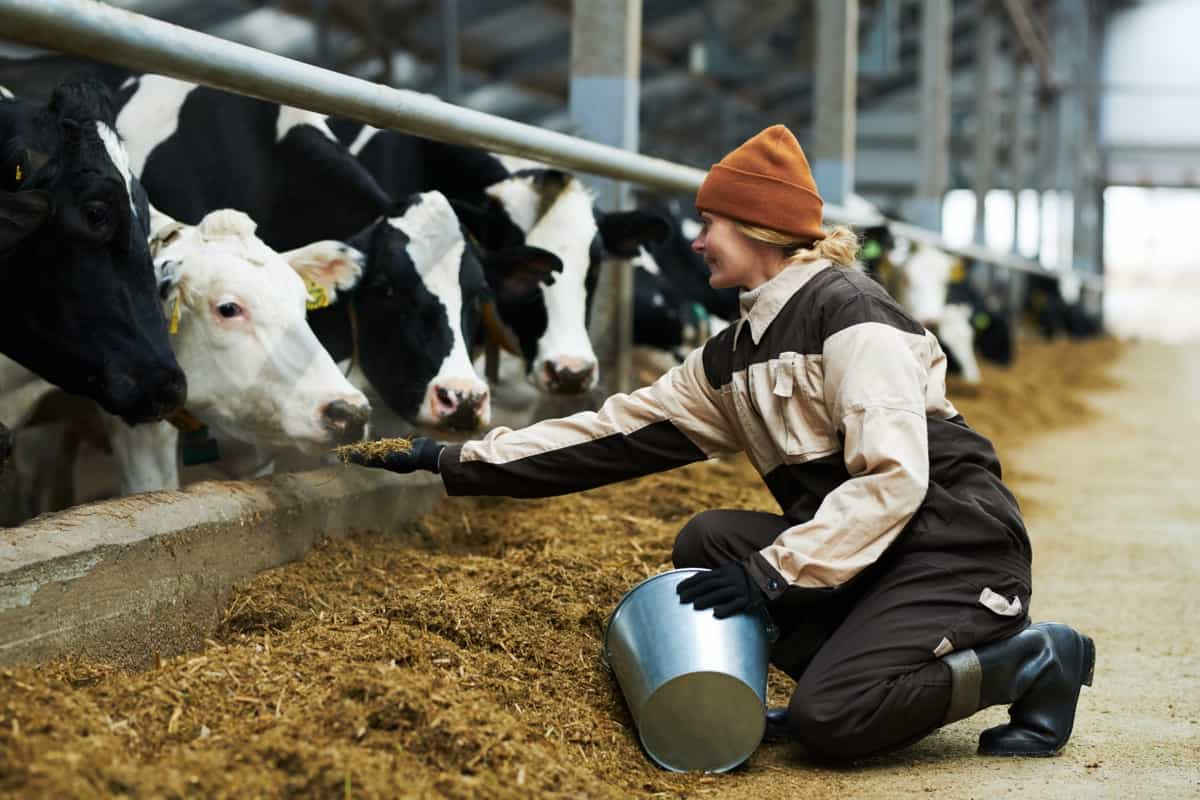
How to Select the Best Dairy Cattle Breeds for Your Farm
Dairy cattle are cows that produce milk for human consumption. There are many different breeds of dairy cattle, each with advantages and disadvantages.
Milk production is the milk a cow can produce in a lactation period, usually measured in kilograms or pounds. Some breeds, such as Holstein, Jersey, and Brown Swiss, are known for their high milk production, while others, such as Guernsey and Ayrshire, produce less milk but with higher butterfat content.
Feed efficiency is the ratio of milk output to feed input, or how much milk a cow can produce from a given feed. Feed efficiency is important for reducing costs and environmental impact. Some breeds, such as Jersey and Brown Swiss, are more feed-efficient than others, such as Holstein and Guernsey.
Adaptability: This is the ability of a cow to thrive in different climates, altitudes, terrains, and management systems. Adaptability is important for ensuring the health and welfare of the animals. Some breeds, such as Zebu and Sahiwal, are more adaptable to hot and humid conditions, while others, such as Friesian and Simmental, are more suited to cold and temperate regions.
Disease resistance: This is the ability of a cow to resist or recover from common diseases and parasites that affect dairy cattle. Disease resistance is important for reducing losses and veterinary costs. Some breeds, such as Sahiwal and Red Sindhi, are more resistant to diseases such as mastitis and tick fever, while others, such as Holstein and Jersey, are more susceptible.
Temperament: This is the personality and behavior of a cow, which can affect its handling, milking, and breeding. Temperament is important for ensuring the farmers’ and animals’ safety and comfort. Some breeds, such as Jersey and Guernsey, are more docile and friendly, while others, such as Holstein and Friesian, are more nervous and aggressive.
20 Best Dairy Cattle Breeds
Holstein
Holsteins, the most popular dairy cattle breed, originated from the Netherlands 2,000 years ago and were imported to the U.S. in the 19th century. They are the largest U.S. dairy breed, weighing 1,500 pounds and 58 inches tall. They produce about 9 gallons of milk daily, or 2,674 gallons per year, setting a world record. Holsteins are adaptable to various environments but need to be more tolerant of heat, affecting milk quality and fertility. They are easy to handle but prefer herd animals.
In case you missed it: Why You Should Consider These 20 Best Beef Cattle Breeds for Your Farm
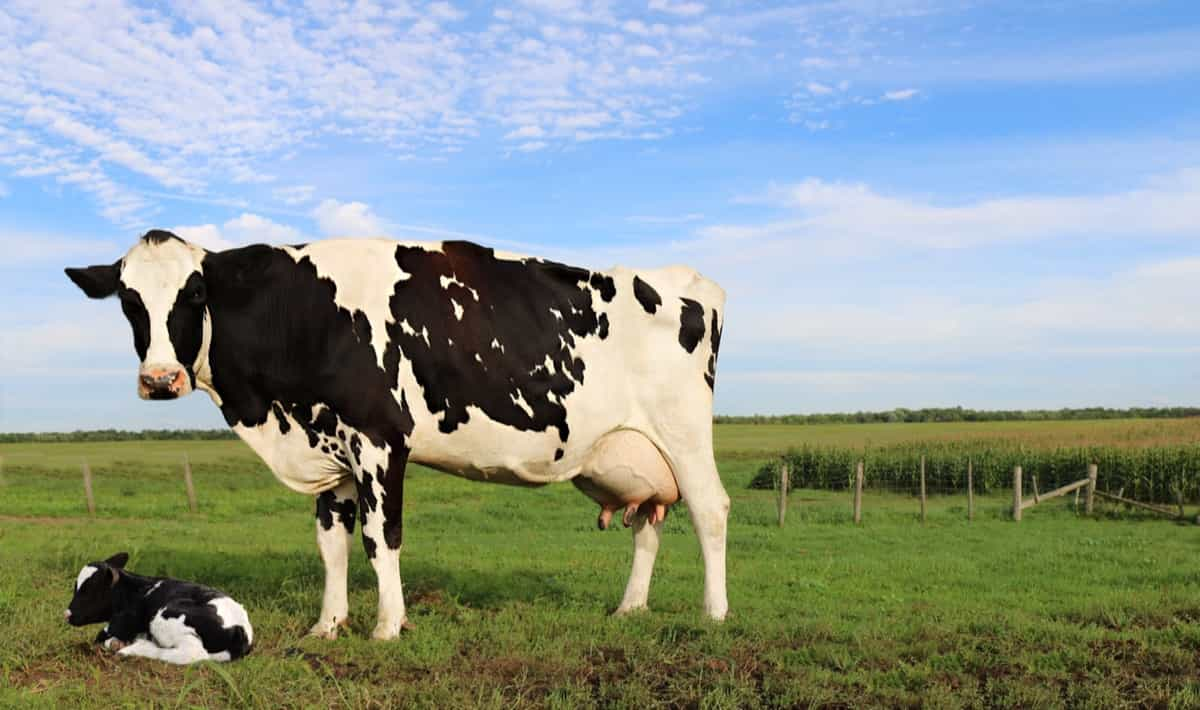
Milking Shorthorn
The Milking Shorthorn dairy cattle breed that originated in the United Kingdom from the Shorthorn cattle of Teesside in northeastern England. The breed is known for its red, white, or roan coat color, high fertility, grazing efficiency, and ease of management. The breed can produce about 7000 kg of milk annually, with about 3.8 percent butterfat and 3.3 percent protein. The breed is also durable, long-lived, and calm in temperament.
Dutch Belted
Dutch Belted cattle, recognized by their striking white belts around their midsection, are a unique dairy breed. Their distinctive appearance is as impressive as their milk production. These cows are known for their high-quality milk, producing an average of 22,000 pounds annually.
What sets them apart is their exceptional foraging abilities and resilience in various climates. With a gentle disposition, Dutch Belted cattle are also easy to handle, making them choice for dairy farming. Their eye-catching looks and impressive milk yields make them a special addition to any farm.
Swedish Red
Swedish Red cattle, known for their distinct rust-red color, offer exceptional milk production capabilities. These hardy and adaptable animals can thrive in various climates. On average, a Swedish Red cow produces approximately 7,000-10,000 kilograms of milk per year with a high milk fat and protein content. Their exceptional fertility and longevity make them a popular choice among dairy farmers. Additionally, these cows exhibit gentle temperaments, making them easy to handle.
Norwegian Red
The Norwegian Red cattle breed is renowned for its outstanding features in dairy farming. These cows are prized for their remarkable milk production, consistently delivering high-quality milk. They possess exceptional health and fertility traits, making them a sustainable choice for any farm. Norwegian Reds are also known for their adaptability to various climates. They are productive and visually striking with a distinctive red coat and white markings.
Jersey
Jersey is a breed of dairy cattle originating from the island of Jersey in the English Channel. Jersey cows are known for their high-quality milk, which has a high butterfat and protein content. Jersey milk is also rich in calcium, vitamin A, and vitamin D. Some of the special features of Jersey cows are their small size, docile temperament, and distinctive fawn color. Jersey cows can adapt well to different climates and environments. They are also efficient converters of feed into milk, which makes them economical to raise.
In case you missed it: Lumpy Skin Disease in Cattle: Causes, Symptoms, Treatment, and Control
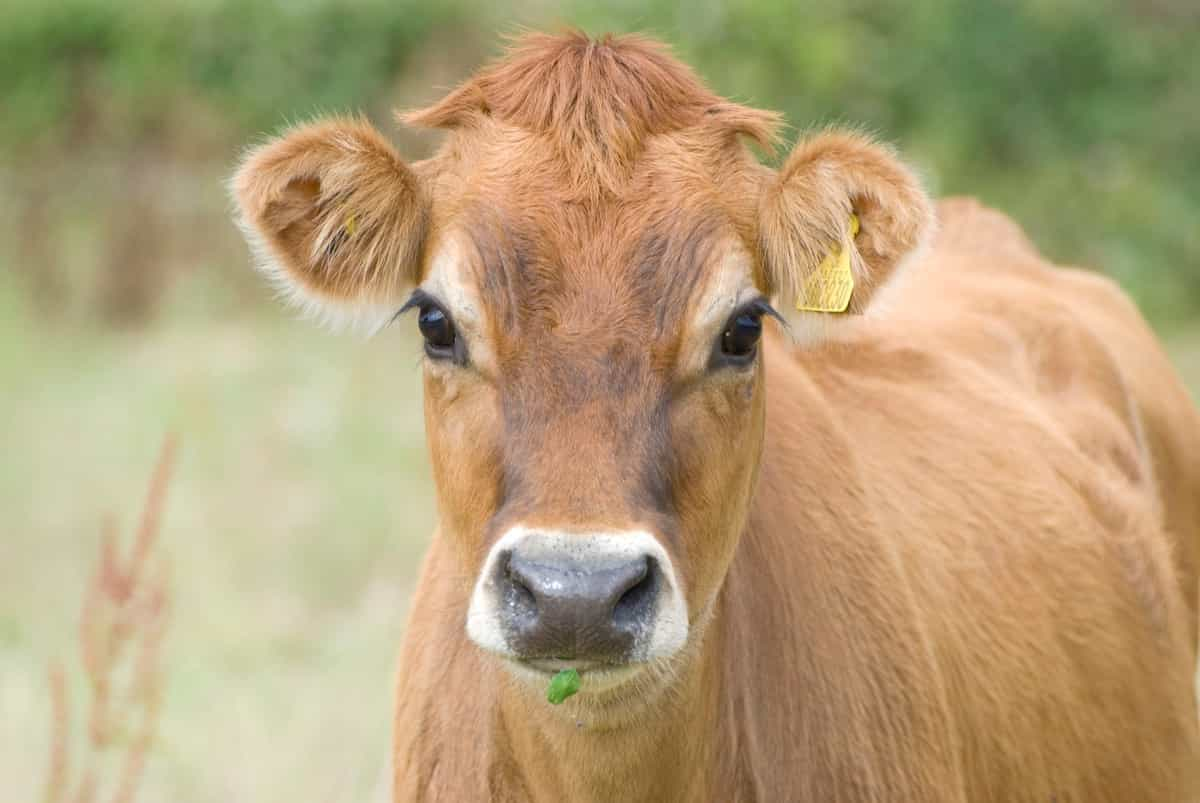
Brown Swiss
Brown Swiss are a breed of dairy cattle originating from the Alpine region of Europe. They are known for their high milk production, which averages 10231 kg per year, with about 4% butterfat and 3.5% protein. Their milk is suitable for making cheese. Brown Swiss have a light brown or gray coat and are heavier and thicker than other dairy breeds. They are also adaptable to different climates and altitudes.
Normande
The Normande is a dairy cattle breed known for its distinctive characteristics. These cows exhibit a reddish-brown coat and boast a calm temperament, making easy to handle. In terms of milk production, Normandes are known for their exceptional-quality milk, which is rich in butterfat and protein. This breed is also recognized for its adaptability to various climates. While they don’t possess unique characteristics, their ability to thrive in diverse conditions and provide high-quality milk sets them apart in the dairy industry.
Montbeliarde
The Montbéliarde, a dairy cattle breed, is known for its unique features and exceptional milk production. These cows typically have a distinct red and white coat with impressive adaptability to various climates. They are prized for their high milk yield, with an average of 22-25 liters per day, containing excellent butterfat and protein content. Additionally, Montbéliardes often exhibits calm and docile behavior, making managing them easy. This breed’s outstanding characteristics and milk production capabilities make it a popular choice for dairy farmers worldwide.
Danish Red
The Danish Red dairy cattle breed is renowned for its exceptional qualities. These cows are known for their striking red color, and their unique characteristics make them stand out in the dairy industry. They are prolific milk producers, yielding high-quality milk with impressive fat and protein content. Their calm and docile nature makes them easy to handle. Danish Red cattle thrive in various climates and are adaptable, making them an excellent choice for dairy farming.
Fleckvieh
The Fleckvieh dairy cattle breed is renowned for its remarkable attributes. These animals are dual-purpose, excelling in both milk production and meat. A Fleckvieh cow produces around 6,000 to 8,000 liters of milk per lactation. What makes them special is their robust and adaptable nature, thriving in various climates. These cattle are known for their distinctive coloration, combining flecked and white patches, adding a unique charm to your farm.
Ayrshire
Ayrshire cattle are a Scottish breed of dairy cattle that originated in the county of Ayrshire in southwestern Scotland. They have red and white markings ranging from orange to dark brown. They are known for their hardiness, easy calving, and longevity. They can produce up to 20,000 lb of milk per year. They have no special charters, but they are part of the Approved Ayrshire Milk program that certifies their milk quality.
In case you missed it: How to Make Corn Silage: Production and Management Steps for Goats, Sheep, Cows, Pigs, and Cattle
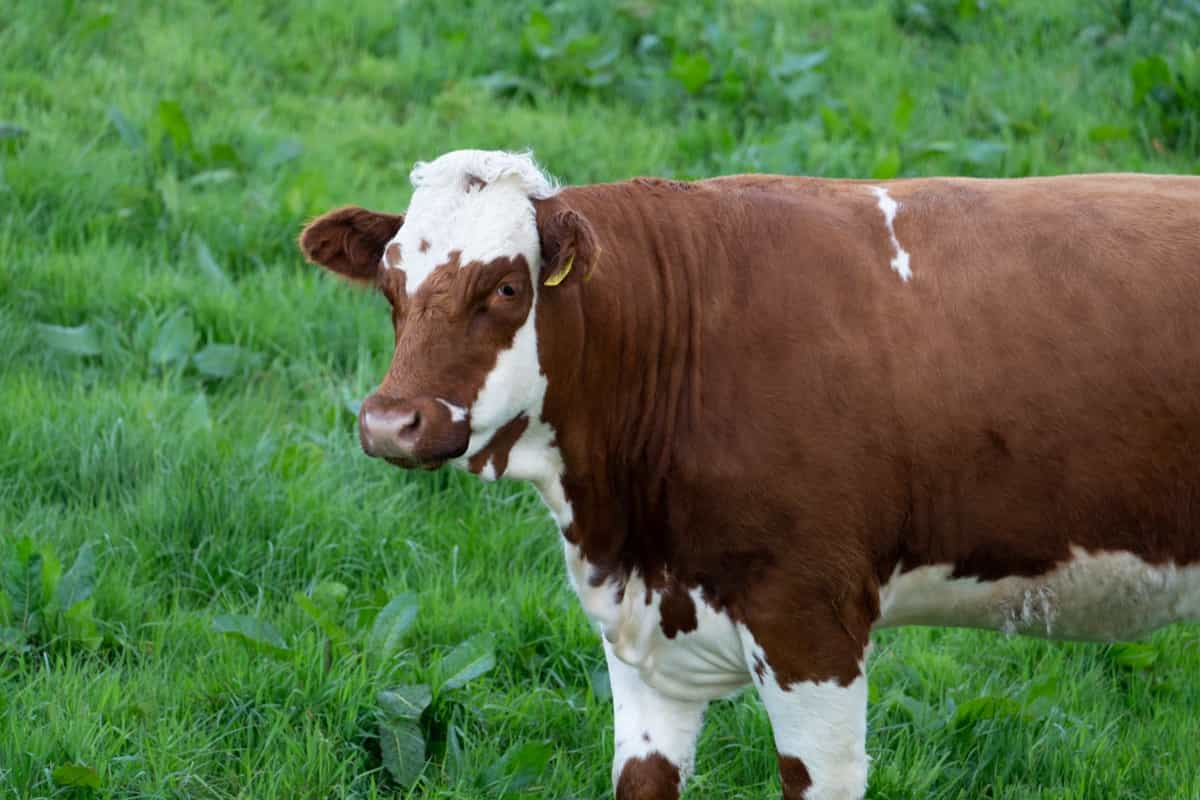
Canadienne
The Canadienne dairy cattle breed is known for its remarkable characteristics. With a history dating back to Canada, this breed excels in cold climates and adapts well to challenging conditions. They exhibit impressive milk production, with an average of 6,000 to 9,000 kilograms per year, containing high butterfat and protein content. What sets them apart are their sturdy, compact frame and exceptional heat tolerance. Canadienne cattle are a top choice for dairy farming in diverse environments.
Dexter
The Dexter dairy cattle breed is a compact yet exceptional choice for your farm. Known for its small size, it’s big on productivity. Dexters produces high-quality milk with a butterfat content ranging from 4% to 5%, making it perfect for cheese and butter production. These hardy cattle are also known for their docile temperament and adaptability to various climates. With their unique combination of milk quality and manageable size, Dexters are the ideal choice for small-scale dairy operations, ensuring both efficiency and quality in milk production.
Simmental
The Simmental dairy cattle breed for its exceptional attributes. These cattle are renowned for their adaptability to various climates and impressive milk production. Simmental cows average yield around 22,000 to 26,000 pounds of milk per year. Their distinctive red and white coat and gentle temperament make them a preferred choice for dairy farming. Simmental cattle are excellent milk producers prized for their beef quality, making them a versatile and valuable addition to any dairy farm.
Charolais
The Charolais dairy cattle breed is renowned for its distinctive characteristics. These cattle are recognized for their white coat and impressive stature. While they are primarily beef cattle, they are also valued for their milk production. Charolais cows yield around 14-20 liters of milk daily, with a 3-4% fat content. Their exceptional hardiness and adaptability make them ideal for various climates. Although not traditional dairy cows, Charolais’ dual-purpose nature and unique qualities contribute to their appeal among farmers.
Guernsey
The Guernsey is a dairy cattle breed from the island of Guernsey in the English Channel. It has a fawn or red and white coat and a cream-coloured muzzle. It produces rich, golden-yellow milk with high fat and protein content. The Guernsey is hardy, docile, and efficient and can graze well on pasture. It is one of the three Channel Island cattle breeds, along with the Jersey and the extinct Alderney.
In case you missed it: Top and Highest Milk Producing Cattle/Cow Breeds in India: Best Guide for Beginners
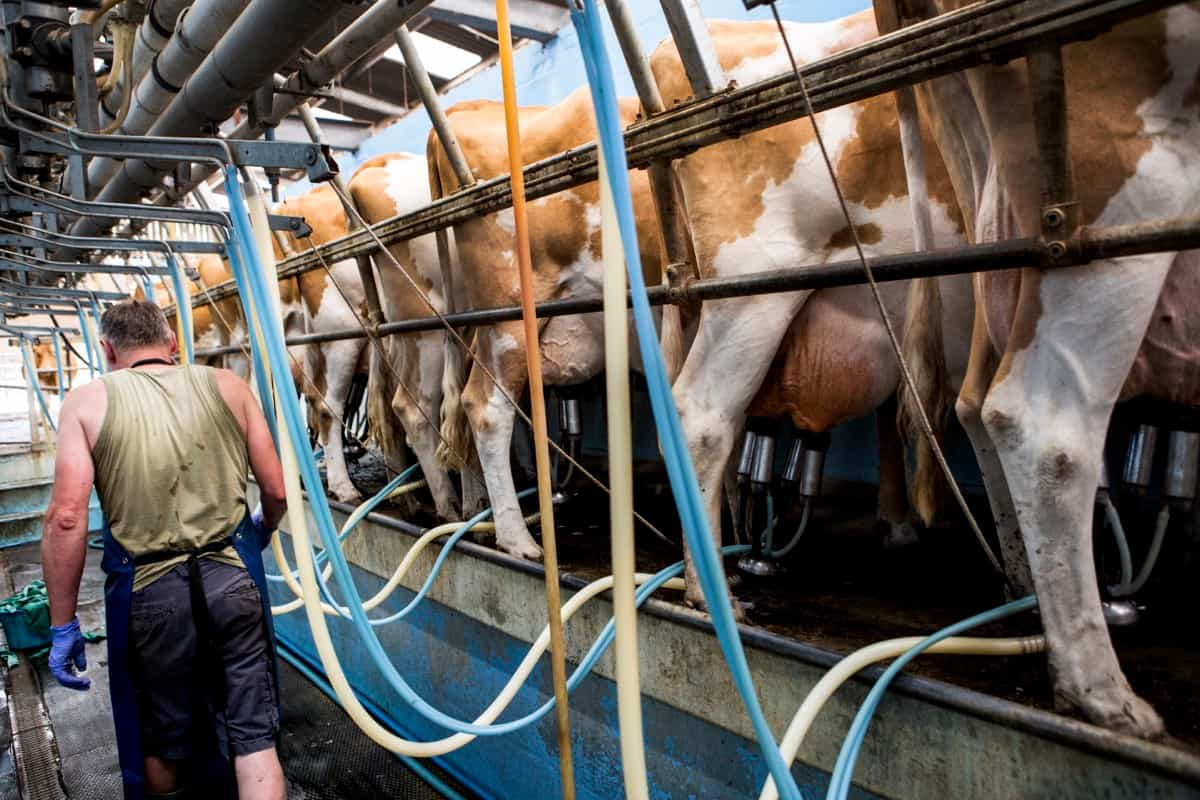
Red and White Holstein
Red and White Holsteins, a distinctive subset of the Holstein breed, stand out with their striking red and white coat. These dairy cows are renowned for their exceptional milk production, averaging 22,000-230,000 pounds annually. They possess a remarkable ability to convert feed into milk efficiently. With a calm temperament, they are easy to manage. One unique feature is their red coat color, which sets them apart from the traditional black and white Holsteins. This breed’s milk is prized for its high butterfat content, making it a popular choice among dairy farmers.
Tarentaise
The Tarentaise dairy cattle breed is renowned for its exceptional characteristics. These cows are prized for their chestnut brown coats and white faces, which make them easily identifiable. Regarding milk production, Tarentaise cows yield high-quality, butterfat-rich milk, averaging around 18,000 to 20,000 pounds per year. Their calm temperament and adaptability to various climates make them a favorite among farmers. Regarding special traits, their strong maternal instincts and longevity in the herd stand out, contributing to their popularity in the dairy industry.
Kerry
Kerry cattle, hailing from Ireland, are a unique dairy breed renowned for their adaptability and hardiness. These cows are medium-sized and possess distinct reddish-brown coats with white faces. While they may not be top milk producers, their milk is prized for its high butterfat and protein content, ideal for premium dairy products. Kerry cattle are exceptionally docile and easy to manage, making them a favored choice for smaller farms.
Comparison of Best Dairy Cattle Breeds for Your Farm
| Breed | Milk Quantity (liters per lactation) | Cattle Cost (Rs.) |
| Holstein | 10,000 – 12,000 | 250,000 – 300,000 |
| Jersey | 5,000 – 6,000 | 150,000 – 200,000 |
| Brown Swiss | 7,000 – 8,000 | 180,000 – 230,000 |
| Ayrshire | 6,000 – 7,000 | 160,000 – 210,000 |
| Guernsey | 5,500 – 6,500 | 170,000 – 220,000 |
| Milking Shorthorn | 5,000 – 6,000 | 140,000 – 190,000 |
| Dutch Belted | 4,500 – 5,500 | 130,000 – 180,000 |
| Red and White Holstein | 10,000 – 12,000 | 250,000 – 300,000 |
| Normande | 4,500 – 5,500 | 150,000 – 200,000 |
| Montbeliarde | 6,500 – 7,500 | 170,000 – 220,000 |
| Swedish Red | 6,000 – 7,000 | 160,000 – 210,000 |
| Norwegian Red | 6,000 – 7,000 | 160,000 – 210,000 |
| Danish Red | 6,000 – 7,000 | 160,000 – 210,000 |
| Fleckvieh | 7,000 – 8,000 | 180,000 – 230,000 |
| Simmental | 7,000 – 8,000 | 180,000 – 230,000 |
| Charolais | 4,500 – 5,500 | 130,000 – 180,000 |
| Tarentaise | 4,500 – 5,500 | 130,000 – 180,000 |
| Kerry | 3,500 – 4,500 | 120,000 – 170,000 |
| Canadienne | 4,000 – 5,000 | 120,000 – 170,000 |
| Dexter | 2,500 – 3,500 | 100,000 – 150,000 |
In case you missed it: Top Cattle Feed Manufacturers in India: Companies List
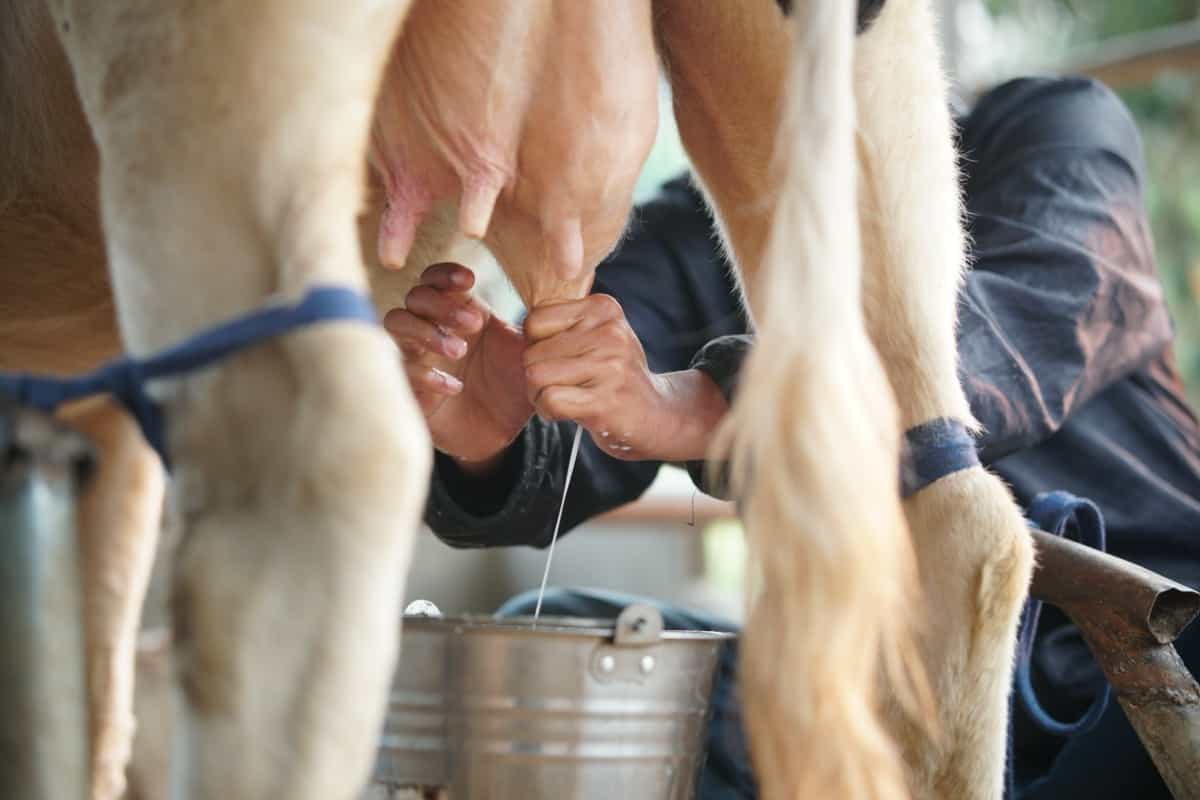
Conclusion
The right choice of dairy cattle breeds can be a game-changer for your farm’s profitability. These top 20 breeds offer a winning combination of milk production, quality, and adaptability. Investing in the best breed suited to your farm’s needs is a step towards a prosperous dairy enterprise.
- Types of Pesticides Used in Agriculture: A Beginner’s Guide
- Economical Aquaculture: A Guide to Low-Budget Fish Farming
- 15 Common Planting Errors That Can Doom Your Fruit Trees
- How to Make Houseplants Bushy: Effective Tips and Ideas
- Innovative Strategies for Boosting Coconut Pollination and Yield
- Pollination Strategies for Maximum Pumpkin Yield
- The Complete Guide to Chicken Fattening: Strategies for Maximum Growth
- Natural Solutions for Tulip Problems: 100% Effective Remedies for Leaf and Bulb-Related Issues
- Revolutionizing Citrus Preservation: Towards a Healthier, Greener Future
- Natural Solutions for Peony Leaf and Flower Problems: 100% Effective Remedies
- Maximizing Profits with Avocado Contract Farming in India: A Comprehensive Guide
- Natural Solutions for Hydrangea Problems: 100% Effective Remedies for Leaf and Flowers
- The Ultimate Guide to Choosing the Perfect Foliage Friend: Bringing Life Indoors
- From Sunlight to Sustainability: 15 Ways to Use Solar Technology in Agriculture
- The Ultimate Guide to Dong Tao Chicken: Exploring from History to Raising
- The Eco-Friendly Makeover: How to Convert Your Unused Swimming Pool into a Fish Pond
- Mastering the Art of Delaware Chicken Farming: Essentials for Healthy Backyard Flocks
- 20 Best Homemade Fertilizers for Money Plant: DIY Recipes and Application Methods
- How to Craft a Comprehensive Free-Range Chicken Farming Business Plan
- Brighten Your Flock: Raising Easter Egger Chickens for Beauty and Bounty
- How to Optimize Your Poultry Egg Farm Business Plan with These Strategies
- Subsidy for Spirulina Cultivation: How Indian Government Schemes Encouraging Spirulina Farmers
- Ultimate Guide to Raising Dominique Chickens: Breeding, Feeding, Egg-Production, and Care
- Mastering the Art of Raising Jersey Giant Chickens: Care, Feeding, and More
- Ultimate Guide to Raising Legbar Chickens: Breeding, Farming Practices, Diet, Egg-Production
- How to Raise Welsummer Chickens: A Comprehensive Guide for Beginners
- How to Protect Indoor Plants in Winter: A Comprehensive Guide
- Ultimate Guide to Grow Bag Gardening: Tips, Tricks, and Planting Ideas for Urban Gardeners
- Guide to Lotus Cultivation: How to Propagate, Plant, Grow, Care, Cost, and Profit
- Agriculture Drone Subsidy Scheme: Government Kisan Subsidy, License, and How to Apply Online
- Ultimate Guide to Raising Araucana Chickens: Breed Profile, Farming Economics, Diet, and Care
- Bringing Hydroponics to Classroom: Importance, Benefits of Learning for School Students
- Ultimate Guide to Raising Polish Chickens: Breed Profile, Farming Economics, Diet, and Care
- Ultimate Guide to Raising Australorp Chickens: Profile, Farming Economics, Egg Production, Diet, and Care
- Silkie Chicken Farming: Raising Practices, Varieties, Egg Production, Diet, and Care
- Sussex Chicken Farming: Raising Practices, Varieties, Egg Production, Diet and Care